
You will not be going anywhere for a while! Tell your family you will be stretching and folding for the next 3.5 hours…
The last few months we have been making quite a lot of these loaves. We made them with tiny variations and alterations, experimenting with flour, water, times and temperature and above all quantities. We even developed a hybrid version for the baker in a bit of a hurry. We are now pleased enough with the results to share them with you.
To most bakers the name Tartine does not need further introduction. A lot of home bakers will know the book, the bakery in San Francisco or even the bread. When you look at the pictures in the book, you just want to make that bread too! It’s attractive and impressive. Just one tiny remark about the recipes. We found that some of the essential information was pretty well hidden in a lot of text and it needs careful reading to avoid mistakes and there seems to be some errors in the bakers percentages. We tried to be clear and unambiguous with our version of this recipe and for that we made a few changes. The result to us is an outstanding bread with a very pleasant crumb structure and ‘bite’ and complex taste.
We make these loaves in both cane and wood-fibre proofing baskets and shape as boules or batard. Whatever your personal preference, the wonderful taste stays the same!

What’s different from the original?
The most important change we made is one that all home bakers should be pleased with. We scaled the amount of sourdough culture back to manageable proportions, avoiding unnecessary waste of flour. Instead of maintaining a 400 grams culture all the time, we changed it by building a poolish the night before with a small amount of sourdough culture.
We recalculated the ingredients to a smaller loaf of about 770 grams. In the recipe below you will also find the percentage of whole wheat flour a bit higher than the original.
Also we recalculated and adjusted the hydration level to be 70% as our European flour absorbs less water than American and the original Tartine recipe does some strange bakers percentage calculations.
No need to knead, but….
There is some serious stretching and folding to be done. It is also the beauty of this recipe that all the dough is developed without the aid of a mixer. So even if you want to make 12 loaves, no worries about mixer capacity with this recipe. Everything is done by hand. You feel the dough changing under your hands. We use a big rectangle food grade plastic container to make batches of 12 breads.
Use our Dough Calculator
Below the ingredients lists you will see a ‘dough calculator’ button. Click on the button to open. Now it is very easy to change the total amount of loaves and amounts of flour to make smaller or larger breads. You can also change the bakers percentages to adjust the ratio between the ingredients like water or salt. And last but not at all least you can calculate the exact temperature of the dough!

Before you start
For this recipe we are going to make a starter named a poolish. A poolish is a type of wet sponge usually made with an equal weight of water and flour and a small amount of sourdough starter culture or yeast and NO salt. Making a poolish helps bring more taste and strength to your bread.
We use a sourdough culture which is made with 100% whole grain rye flour. A sourdough culture based on rye flour is easier to maintain, does not go into a slurry when you forget about it, is easier to stir because it has almost no gluten and smells very nice, a bit like fruit. It is also very forgiving in the amount you feed it, everything seems to be alright. Normally we only feed it once a week, after our weekend baking we give it a few table spoons of water and rye flour, stir, ready!
Ideally the temperature of your dough after mixing should be around 24-25 ºC / 75 ºF. You should adjust the temperature of the water you add, so the total dough reaches this temperature. For us this means in summer adding cold water to this recipe and in winter (when our little bakery gets much colder then the rest of our house) adding warmer water. You can measure the temperature of water and dough with a food thermometer. These measurements are important because they correspond with the proving times in the recipe.

| Ingredients for the Poolish | ||||
|---|---|---|---|---|
| 25 | g | wheat (bread) flour | ||
| 25 | g | whole wheat flour | ||
| 10 | g | sourdough culture | ||
| 45 | g | water (room temperature) | ||
| Ingredients for the Tartine Style Bread | ||||
|---|---|---|---|---|
| makes 1 loaf | ||||
| the poolish from step 1 | ||||
| 350 | g | wheat (bread) flour | ||
| 40 | g | whole wheat flour | ||
| 240 | g | water part 1 | ||
| 20 | g | water part 2 | ||
| 6.5 | g | (sea) salt | ||
| 2 | g | instant yeast (optional hybrid version, see text at bottom recipe!) | ||
Making the Poolish
When we make this recipe we make 12 loaves at a time and that is why we do not make the poolish in the big box we use for the final dough (it would spread too thin). But if you make less loaves it totally makes sense to make the poolish and your dough in the same bowl. A good method for making this bread and keeping your worktop clean!
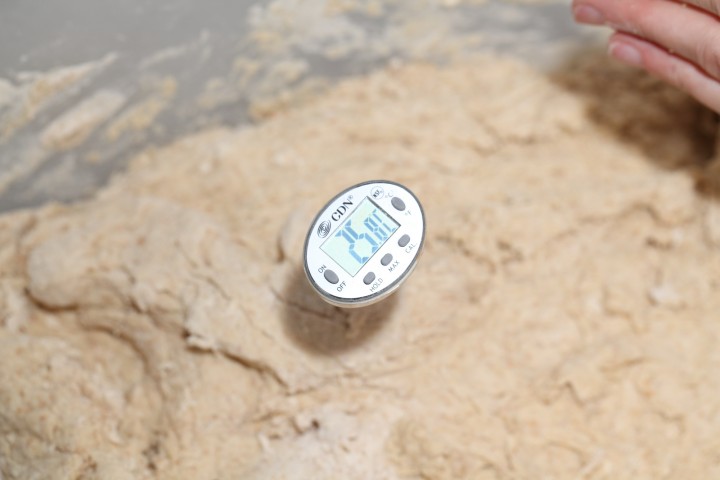
Now in your bowl stir together the bread flour, whole wheat flour and the water at room temperature with the sourdough culture. Mix it well until you have a homogeneous slurry that looks like very thick batter. Cover the bowl with clingfilm and let the prefermenting begin. After 12 hours at room temperature it should be bubbly, light and ready for use. So if you want to begin your bread making in the morning, you should make your poolish at 9 in the evening.
Making the Tartine Style Bread
Take your bowl with the poolish and add water part one (around 32ºC) plus all of the flour but NO SALT. Combine with your hands or a dough whisk until all the water is incorporated.
Leave the dough in your mixing bowl, cover and let rest for 20 minutes (this technique is also referred to as autolyse).
Now add the salt on top of the dough and then add water part two, making sure the salt gets wet. Squeeze the dough with your hands to combine water and dough until smooth and all water has been absorbed. This should take only 1 or 2 minutes.
Again leave the dough in your bowl, cover and let rest for 30 minutes.
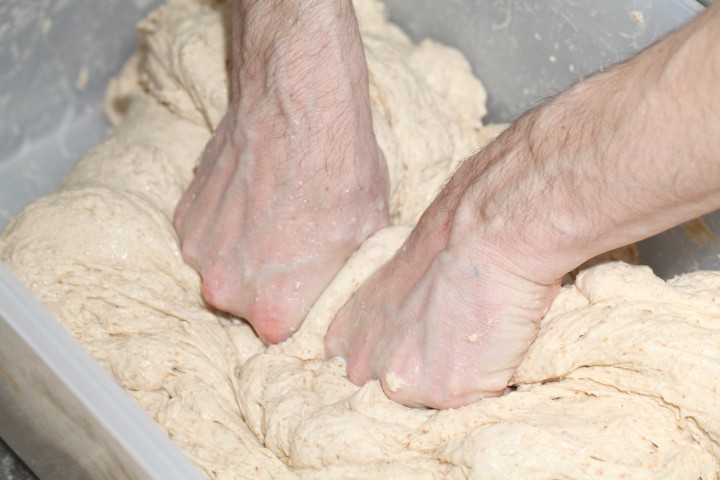
Stretching and Folding Stage
Wet your hands a bit before you start to stretch and fold, this will make it easier to handle the dough. Now do your first stretch and fold while leaving your dough in the bowl. Do a full letter fold, left over right, right over left, bottom over top, top over bottom. Watch our bread movie or our stretch and fold method video to observe this technique if you are not familiar with it.
Cover and again leave to rest for 30 minutes. Repeat the stretch and fold (full letter fold) five more time (so six times in total) each time leaving the dough to rest for 30 minutes. The whole process takes 3,5 hours.

Shaping and Proofing Time
After the last 30 minutes rest it is time to shape your dough. You can make oblong (batard) or round (boule) loaves of bread, whichever you prefer. For instructions on how to shape a boule, take a look at our boule shaping video.
Because this is a true sourdough bread, the final proof will take quite a long time. Please take that time and make sure your dough is really ready for the oven.
Transfer the shaped dough to a proofing basket / banneton, cover and leave to proof for 2 hours and 30 minutes. When you think it has risen enough, use your finger to carefully make a very small dent in the dough. If the dent remains, the bread is ready, if the indentation totally disappears, the dough needs a little bit more time.
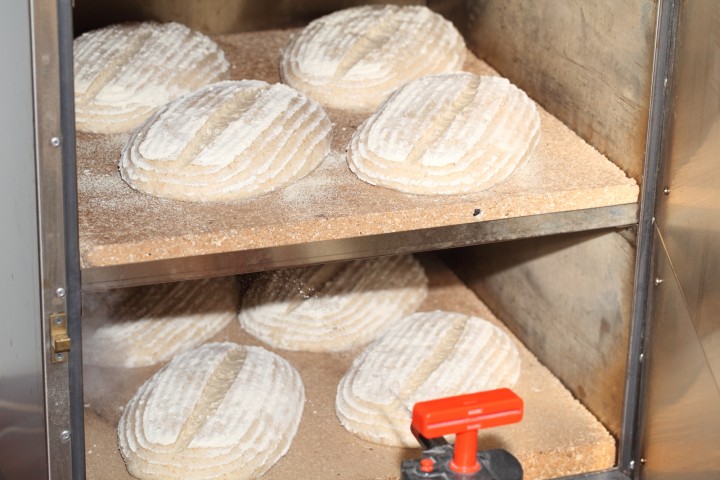
Baking
Preheat your oven to 230 ºC / 445 ºF (at what stage you preheat your oven depends on how long it takes for your oven to heat through, some take 30 minutes, some, like ours, with stone floors take a lot longer, up to two hours.
Now your loaf is ready for the oven. Slash the top of the loaf with a lame or bread scoring knife.
To get a nice crust, try to create some steam in your oven by putting a small metal baking tray on your oven floor when you preheat the oven, and pour in half a cup of hot water immediately after putting the bread in the oven. Release some steam by setting your oven door ajar (perhaps with the help of a wooden spoon or oven mitt) 5 minutes before the bread is ready. If you are going to create steam with a baking tray, you may also want to turn your oven temperature a bit higher, because you are going to lose some heat in the process.
After 45 minutes of baking your loaf should be ready. Transfer onto a rack and leave to cool. This loaf also keeps very well in the freezer.

Tartine Style Bread Time Table
Day 1 – 21.00 h Make poolish let ferment for 12 hours at room temperature
Day 2 – 0.900 h Make final dough
- 09:00 – Add flour and water part 1 to starter, combine
- 20 minutes rest (autolyse)
- 09:20 – Add water part 2 and salt, combine
- Rest for 30 minutes
- 09:50 – Stretch and fold 1
- Rest for 30 minutes
- 10:20 – Stretch and fold 2
- Rest for 30 minutes
- 10:50 – Stretch and fold 3
- Rest for 30 minutes
- 11:20 – Stretch and fold 4
- Rest for 30 minutes
- 11:50 – Stretch and fold 5
- Rest for 30 minutes
- 12:20 – Stretch and fold 6
- Rest for 30 minutes
- 12:50 – Shape
- 12:55 – Final proofing 150 minutes
- 15.35 – Bake for 45 minutes at 230ºC / 445ºF
- 16:20 – Your bread is ready!

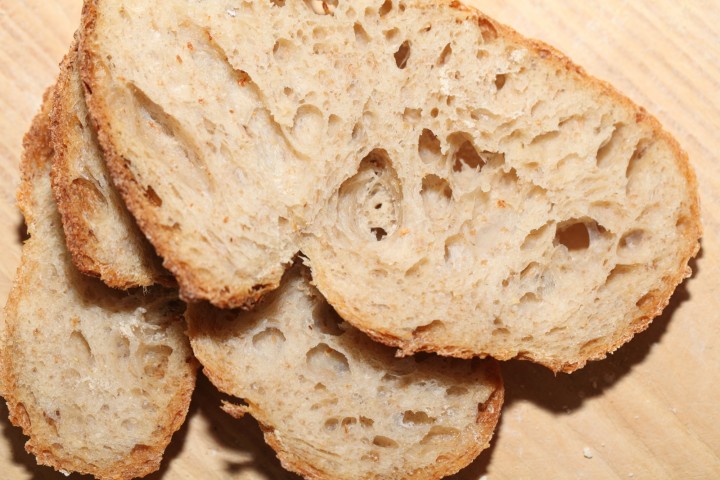
Making the Quicker Hybrid Version
If you want to make a quicker version of this recipe you can opt for the hybrid version. With hybrid we mean a bread that uses both sourdough culture plus a small amount of yeast to speed up the proofing of the final dough.
For this version you must use 2 grams of instant yeast per loaf in the final dough. You add the yeast together with the salt on top of the dough after the autolyse fase.
You can limit the stretching and folding to 2 hours but do two sets of complete stretch and folds every 30 minutes, 3 x 2 sets in total. The final proofing will be around 1 hour.




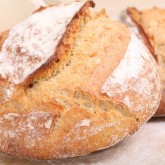

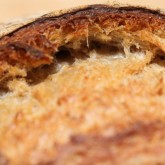
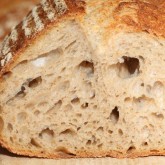


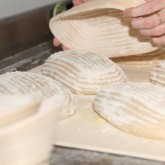


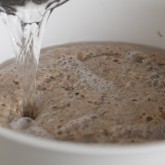

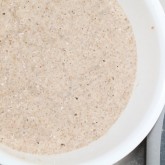

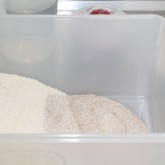
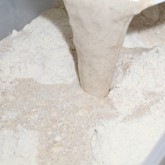

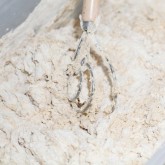

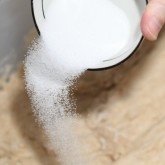
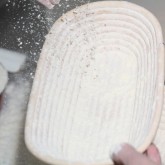
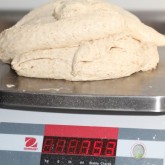

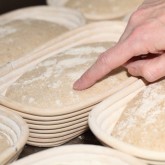
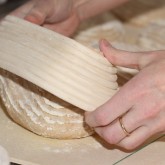






Peter Higgins says
Used the hybrid method because I was short of time, and even then ran out of time. So, after shaping and popping into a banneton, I covered and left it in the fridge overnight. Baked in the morning after an hour in a warm kitchen and enjoyed exquisite flavour.
My starter comes from Richard Bertinet’s ‘Crust’ recipe using white and Spelt flours.
Weekend Bakers says
Thank you Peter for sharing your method. This will be useful for many other bakers.
Enjoy your sourdough!
Chris Whlitelonis says
I made this today for the first time. I used all rye starter and more rye in the poolish , then rye instead of whole wheat. I turned out great!
Pelle says
This is my go-to recipe, I usually bake these inside my cast iron dutch oven (braadpan), they’re absolutely fantastic.
My question is: I’d love to do 4 loaves in one day, but can only bake one at a time, so I need to slow down the process on the later ones. What is the best time to put part of the dough in the fridge? Is it best to do that after they’re fully proofed, so you can put them straight from the fridge in the oven? Or is it better to do it earlier, e.g. right after shaping them, or even before? And if so, how do you determine when to take them out of the fridge again, given the different temperature?
Eve says
If using poolish, could I put the dough after shaping in the fridge to retard until next morning to bake? Or it would be too long time
Chris Whlitelonis says
You can hold it in the fridge over night, let it come to room temp. before baking.
Melissa says
Hi! Thank you for this adaptation. I’ve been using the tartine version for years, but lately been a bit disappointed in the results. Maybe a change in flour or too much experimentation. Anyway, I needed a reboot and your recipe was a lovely chance to do that.
My bread dough was so much lighter and easier to work with than the tartine one, and my starter loved it almost too much. I caught it right before she overproved right out of my basket!
Quick question for you. The bread turned out beautifully, but it is very soft and delicate. Softer than sandwich bread. I’m thinking it’s maybe because I used 100% white bread flour and left the lid on my ceramic bread baker for 30 minutes, and only baked it off for 20. It’s quite hard to cut without crushing it though, because the inside is so soft and the crust has gone soft/leathery. Any advice on getting a bit more strength, or at least a sturdier crust? Thanks!
Geert Vermeersch says
Hallo weekendbakery! Deze keer verliep het niet naar behoren. Het deeg kwam moeilijk los van de mandjes (hoewel heel erg gebloemd) en dan ook niet van de bakschep (hoewel rijkelijk bestrooid met griesmeel) wat zou ik fout gedaan kunnen hebben? Dank je wel!
PS Mijn Pain Naturel in baguette vorm daarentegen. FANTASTISCH!!!
Weekend Bakers says
Hallo Geert,
Tja, dat is lastig te zeggen. Hebt u een nieuwe of andere zak bloem / meel gebruikt die net wat minder absorptie had. Het weer kan een rol spelen, de temperatuur en vochtigheid, de rijstijd of wellicht een kleine weegfout. Of een combinatie van factoren.
Dat hoort ook bij het brood bakken en wij hebben ook onze momenten en dagen dat het net iets anders en vooral minder loopt of een brood wat minder wil. Vooral met desem is het consequent perfect bakken een uitdaging, omdat de samenstelling en het enthousiasme van het toegevoegde desem ook aan verandering onderhevig is.
Gewoon lekker doorbakken zeggen wij dan. En altijd goed kijken naar het deeg, de ‘look and feel’ om te beoordelen of de hydratatie in orde is of bijgesteld moet worden.
Enjoy your baking en nogmaals dank voor uw enthousiasme!
Ed & Marieke
Geert Vermeersch says
Dank je wel. We doen verder, zelfs met een surrealistische vorm smaakte het brood heerlijk!
Weekend Bakers says
Prachtig 🙂
Doughmer says
This whole write up is brilliant! Can you please explain why you choose to do a poolish rather than just doing a rye starter all the way? Thanks!
Weekend Bakers says
Hello Doughmer,
You can read more about our method and the reason why with our handy sourdough tips:
www.weekendbakery.com/posts…ough-tips/
It is also explained above under: What’s different from the original?
Enjoy your sourdough baking and thank you!
Thomas Cappiello says
In the Tartine book Chad dissolves the salt in the reserved water first, I’ve never understood why. Is it to keep the salt from harming the gluten, or it is just a means of increasing hydration, like a basinage?
Weekend Bakers says
Hello Thomas,
We are not sure, we have never done it ourselves, did not have the need I guess, but it would be interesting to find out more and give it a try.
Oxana Matthey says
Weekend Bakers, I used the original Country Loaf recipe but the reason it came out to be the best smelling, tasting, and looking bread ever is because of all the things I learn here every day – the stretch and fold, the boule shaping, the calculator, the proof test, and baking on a stone. In fact I was switching between the two sites the entire time. My next baking conquest – your 80% baguette. Thank you!
Weekend Bakers says
Wonderful Oxana, so glad all these things together are aiding you in becoming a great and above all enthusiastic baker!
Gilberto says
Thank you for the detailed information and the very nice website. I have been trying variations of this recipe (the one on the NYT, and several youtube tutorials) since a while, but I always ended up with a wet, sticky, and unmanageable dough, which did not have enough structure to support the oven rise, so I always ended up with a flat bread. I had decided to try and lower the hydration level, but somehow ended up here and found the key observation that american flours absorb more water than European ones. The sounded like the solution to my problems, and indeed I tried your recipe and succeeded to get a nice oven spring, and a soft, airy crumb.
Best loaf yet. By the way, I used German wheat flour, a mixture of 550 (3/4) and 1050 (1/4), and added 12 hour of fridge before baking (in a Dutch oven). Also, my poolish needed 7 hours to peak. I will start from here to experiment more.
And will try more recipes from your site.
Thanks a lot!
Weekend Bakers says
Hi Gilberto,
Thank you for sharing your feedback and experience with the recipe. We love the fact that you are now closer to the result you are looking for and are glad we could play a small part in hopefully rekindling your enthusiasm for baking this type of bread.
Greetings from Holland,
Ed & Marieke
WKB
Thomas Cappiello says
yeah, Chad’s 75% hydration is crazy. I know some people that even go higher, I have no idea how they do it. I use 68% and although I get a bit smaller crumb, its incredibly consistent and I have customers that love it.
Weekend Bakers says
We completely understand Thomas, this is how we would do it too!
Jennifer says
My best loaf yet! All the open crumb of a high hydration loaf, but much easier to work with, shape, etc. Your website has been my most reliable resource ever since I used your recipe to make sourdough starter. Thank you so much!
Weekend Bakers says
We can only say thank you back Jennifer and are very happy we can be a part of your baking success and joy this way.
Lots of loaves!
Ed & Marieke
patricia keser says
Vandaag heb ik dit recept gevolgd. Was zo benieuwd met die 6x s&f. Maar na exact alles volgen, een overrijs! Deeg deukt in en veert niets meer terug. Wil ook niet rijzen in de banneton. Erg plat brood. Ik ga hem nu toch maar bakken, maar vraag me af waar het dan fout gegaan kan zijn….
Weekend Bakers says
Hallo Patricia,
Je geeft zelf al aan dat je deeg is over-rezen. Hoe dat komt dat kan bij zuurdesem aan het enthousiasme van jouw specifieke cultuur liggen, of aan de temperatuur waarbij je laat rijzen of beide. Ook kan het wellicht zijn dat je poolish al te ver ontwikkeld was en dat je dat ook zag bij het toevoegen (al wat dunner, soepiger en geen stevige elastische structuur meer, dus kapotte gluten). Je moet het de volgende keer dan aanpassen en tijden wat verkorten en de poolish eerder gebruiken (beter onderontwikkeld dan over-).
Het is echt niet raar als een recept niet zomaar lukt, dat hebben wij en alle andere bakkers ook. Geef jezelf de tijd om je het recept eigen te maken. Bij ons duurt dit ook minimaal 3 en soms zelfs wel 10 x, vooral met een wat uitdagender proces.
Succes ermee!
Riccardo says
Hi WKB,
I am an Italian expat in the Netherlands and I recently picked up the passion to bake sourdough bread (before I was making only pizza (: ). I am really happy I found your website, it is amazingly helpful, especially to understand the weird world of Dutch flour. I read a lot of your blog posts and today I stumbled upon this one because I am trying to make the basic country bread from the Tartine book.
I followed the original recipe and I baked already 4 loafs but I also noticed that there was something off. My shaped dough tended to be always quite wet and really hard to score (it came out ok at the end). I will try to make your version tomorrow, I just have a question. In this post you don’t mention the proofing temperature, for bulk fermentation etc. Do you use a proof box or you leave the dough at room temperature? My room temperature with this weather is currently 19 degrees.
Weekend Bakers says
Hello Riccardo,
Excellent to read about your baking journey in our small country. We understand it is not easy to find your way, especially since the information on bags of flour (if you can get them) is sparse or not easy to understand.
As you can read (or have already done so) in our version of this recipe we made a few adjustments, also reduced the hydration level to adapt it to the absorption of European flour.
We do not use a proofing box, our room temp is almost always around 20 to 21 C. So try and use a spot that is close to this temperature (not near a window or so). We write in the recipe about how we try to get the temp of the final dough around 24 to 25, after kneading.
If you think your dough will be too cold during (final) proofing you can also use your slightly warmed up oven as a proofing cabinet to get the dough just a few degrees warmer.
Hope you will give it a try!
Enjoy the process,
Marieke & Ed
WKB
Riccardo says
Hi Marieke & Ed,
Thanks a lot for taking the time to reply to my comment.
It is now my second week of baking and I tried both the original Tartine recipe and your modified version but I still get quite a flat sourdough. It looks like there is almost no oven spring (I am using a Lodge Combo Cooker pre-heated to 230 for half an hour). I can not really tell what the problem is, at first I thought was over-hydration from the original recipe but also with your modified one I still get similar results. During the shaping phase the dough still feels quite sticky and I am not always able to follow the steps to make it into a boule because it start sticking in my hands. In the end I manage to make a round shape and put it in the banneton but I have the feeling that the dough is not building enough tension. Do you have any suggestions?
Thanks,
Riccardo
Weekend Bakers says
A few questions for you:
What flour are you using? What protein content? Do you use steam in your oven? Also, do you now the true temperature of your oven, so it is not actually less hot than the oven indicates?
Riccardo says
I am using the Molenbloem (Tarwebloem, Eiwitten: 11,4g) and Tarwemeel (Eiwitten: 11,4g) from the Wijchense molen. I have a really bad oven, one of this combi-ovens with microwave (it came with the house I bought), I am using a dutch oven to bake the bread, the Lodge Combo Cooker. The maximum temperature of the oven is 230, I pre-heat the dutch oven for half an hour before baking the bread in it. How do I check the real temperature of the oven? I have only a CDN DTQ450X but I don’t think I can put it in the oven.
Weekend Bakers says
Hi Riccardo,
Yes, we know that mill and have used the flour. If you want to check the real oven temp you need this oven thermometer.
cdnkitchen.com/produ…ermometer/
You could also look at buying some Italian flour (here for instance is where we buy sometimes the Caputo blue: www.italieplein.nl/
It would work well to combine it with the tarwemeel for your loaves and also buns.
Good luck with it!
patricia keser says
Vandaag heb ik dit recept gevolgd. Was zo benieuwd met die 6x s&f. Maar na exact alles volgen, een overrijs! Deeg deukt in en veert niets meer terug. Wil ook niet rijzen in de banneton. Erg plat brood. Ik ga hem nu toch maar bakken, maar vraag me af waar het dan fout gegaan kan zijn….
Athena says
Hello Weekend Bakery! I am excited to try this bread as you’ve laid out the Tartine method in a way I can follow. I use the Ken Forkish Flour Water Salt Yeast Overnight Brown as my standard sourdough method but I want to try the Tartine method (which is very similar) and has a different schedule. We like a higher % of Whole Wheat flour. Would it be possible to increase this recipe WW’s up to about 30-35%? If so, how would you do it since water adjustment would be the biggest factor. Thank you!
Weekend Bakers says
Hello Athena,
Thank you for your comment on the recipe. Hope you have a chance to try it soon, (we always advice to make the recipe the first time as described and only deviate if your result is good) though it takes some time, it is worth it. As for the WW, we never do it with this recipe, but of course you can. It is very hard to give an exact amount or %, it can be anywhere between 2 and 5%. There’s so much difference between flours, you really need to just make it and look at the dough, it should definitely be shiny and sticky. Begin with a small amount we would suggest and take it from there.
Hope it will be great.
Ed & Marieke
WKB
Caroline says
Hi, I’m on day 3 of making a rye sourdough starter, to your instructions, and its starting to bubble nicely. So, now I’m looking ahead to what bread I’m going to make with it in 3 or 4 days, and this one looks good. My questions are: do you think it will work to use spelt whole grain flour? And, do you think it will be ok to cook this loaf in my cast iron casserole? This is my first time making sourdough. Thank you for all your help.
Weekend Bakers says
Hello Caroline,
Great to read your comment. Of course you are more than welcome to try this recipe but If we were to choose a recipe for a novice sourdough baker (if you would be one) we would recommend these ones:
www.weekendbakery.com/posts…n-naturel/
or also a very nice one if you want to make smaller ones is this one:
www.weekendbakery.com/posts…i-boulles/
We would also recommend not to change anything in the recipe before you have made it several times. But if you want to change the small amount of 40 grams whole wheat for whole spelt, that is not a problem.
Baking the loaf in a cast iron dish is very good, it works as an oven in an oven, creating steam and usually producing an excellent crust and ‘oven spring’ .
Hope it will be great. Keep on feeding and refreshing your culture, letting it mature. It will only get better and stronger.
Happy sourdough baking,
Ed & Marieke
r says
I’m a bit conused about poolish…I usually make a “levain” with a little sourdough and equal parts water/flour ( 1:4:4) and leave it until it doubles/triples in volume. That takes about 3-4 hours at room temp (22-24 celsius).
Your poolish seems to be what I call “levain”…but it takes 9 hours! how so? Colder room?
Thanks!
Weekend Bakers says
We understand your confusion. Lots of words for basically the same thing. Your levain with equal amounts of water and flour is a poolish with sourdough (in fact sourdough is also yeast of course).
The poolish for this recipe is even left to ferment for 12 hours! But as you can see the amount of culture added is only 10 grams, so at room temperature it will be ready to use after these 12 hours. But it could be that under your conditions and with your culture, your poolish or levain is at its peak sooner. So if this is the case, you should always use your eyes and experience and adapt to this. It is never a good idea to use an over-ripe levain, because the gluten will be damaged.
slf says
I made it today while in a stay at home order. The bread came out perfectly! Thank you so much! Sourdough is the best for these times.
Weekend Bakers says
Hello SLF, so glad we can be a part of your baking joy this way. So many people all over the world are finding comfort in baking at the moment while at the same time bringing great quality bread to the table for the family to enjoy. Win-win we say 🙂
Stay safe and keep on baking,
Ed & Marieke
Summer says
Love your recipes! A question about starters. My friend just gave a me mature sourdough starter that they’ve been using for years. I was told to feed it with bread flour. I’ve been reading what you say about rye …. Is it possible to convert a starter over to rye if I just start feeding it with that?
Thankyou!
r says
yeap
Weekend Bakers says
Yes Summer, that is no problem, just start feeding it (whole) rye.
Gaby says
Hi,
I’m so happy I found this website. I’m a neighbour and also use Zandhaas’ Windmills flour. I’m starting my sourdough adventure and wanted to try this recipe with fresh yeast in the poolish, could you let me know what that amount should be for the replacement? As you mention it can be done both ways in your recipe.
Looking forward to trying this out and also hoping I can get some flour in the windmill today 🙂
Best,
Gaby
Weekend Bakers says
Hello Gaby,
You are so very lucky living close to our favorite mill 🙂
We moved to the east of Holland in de Achterhoek, which is wonderful in many ways, but we have not yet found a mill that we liked as much as the one from miller Jos. We wanted to visit the mill this month but now everything is a bit different as we all know.
But, we still can bake and that is what brings us joy!
You can use 6 grams of fresh yeast, to replace the 2 grams of instant, but it is used in the final dough, not in the poolish, to speed up the proofing process.
Hope you were still able to get your flour last Thursday.
Greetings and hope you stay safe and find happiness in baking in these challenging times.
Ed & Marieke
Weekend Bakers
Emile says
I have made this bread a lot of times and love it!
I have a question about my latest experiment with this recipe. I like to make it with 100% whole wheat (or sometimes a combination between whole wheat and rye). And although I love the taste, I would love more air pockets in the bread.
After reading a lot, I tried yesterday to make a version with a higher hydration. I didn’t dare 100% what I was reading about, but went for 85%. The final bread is very nice, much more air pockets and amazing taste. But the dough was extremely sticky. I did the six stretch and folds but didn’t do single ones but double or triple to make the dough stronger. But still I couldn’t really shape it and after proofing it stuck horribly to the banetton and when I got it out, it collapsed and lost most of it’s height.
Do you have any tips how to improve this next time? Maybe the six stretch and folds were not enough?
Weekend Bakers says
Your flour needs to be strong in protein / gluten in order to built a strong dough and retain this moisture and it needs to be proofed to perfection. It is a real challenge to get a bread with open structure using whole wheat or rye, because of all the fibers it makes for a denser and ‘heavier’ loaf and there’s less gluten to begin with, especially in the rye.
So make sure you also use strong enough bread flour, do not over-proof and take the hydration % down. So increase from our version with 3 to 5 % and take it from there. Air pockets are also created by not ‘fumbling’ with the dough too much, so keep that in mind too.
Sdu Gerasch says
Oh my goodness, your bread was absolutely delicious. I was a bit skeptical about making it, to my surprise it was a delight working with it. The crumbs were light, fluffy and very tasty.
Thank you so much,
One love from South Africa
Weekend Bakers says
Hello Sdu,
Thank you for taking the time to share your enthusiasm about your results. We love this bread and the method too, you get in some sort of rhythm and it just works.
Greetings from the tiny low countries to your beautiful part of the world.
Enjoy your sourdough baking!
Ed & Marieke
Elisa H says
Can dough be refrigerated overnight after it is shaped, please?
Weekend Bakers says
Hello Elisa,
Yes that is possible, there are several options, but the best place to start is to shape and immediately put it in the fridge and check early in the morning to avoid over-proofing. Best to give it some more time at room temp to get the perfect proof before baking than over-proof and possible collapse of the dough. Also make sure your dough is protected well covered in the fridge to avoid drying out.
Thomas Cappiello says
To cold proof or not to cold proof, that is my question
Weekend Bakers says
Hi Thomas,
We always stick to this recipe as described. If you want to differ from the method, you always need to do so with good reason. What would be your main reason for cold proof?
rye senjen says
Hello There,
we have made up the poolish as per recipe but it was incredibly dry…. added 10 g more water to make a sort of porridge consistency….. we are in australia…any thoughts?
Weekend Bakers says
Hi Rye,
It is supposed to be a bit stiffer, because you use a little less water than flour and also partly whole wheat. But next to this, there’s the consideration that each flour can have different absorption properties, so if you think it too dry, add some more water and possibly subtract it from the liquid in the final dough (but always see how this comes together and what your dough needs for the right consistency). It maybe takes a few tries to get it right for your ingredients and conditions, but it is worth it because this bread can be absolute fantastic!
Hope it will be great,
Ed & Marieke
Abe says
Thank you for the recipe. Fresh out the oven and it was the best oven spring I’ve had.
I used freshly ground spelt instead of whole wheat for the preferment and final dough. Also used a teaspoon of diastatic malt that I made from your instructions.
Everything went just perfect and the smell is divine.
One observation though… I found the 6x stretch and folds a bit too much as the dough wasn’t relaxed enough at just 30 minutes rest in-between. So I did four stretch and folds a but further apart.
Other then that my dough behaved perfectly well and as you explained.
Thank you!
Weekend Bakers says
Wonderful to read your comment Abe and thank you for sharing your thoughts and adjustments. Sounds just perfect and you did well of course to adapt to the circumstances. ‘Sounds’ like baking experience to us!
Greetings and enjoy your baking,
Ed & Marieke
Leslie says
Hi! Ive been reading your (great!) website quite a lot lately, because after much deliberation i finally bought a rofco! So with my mind still set on tartine loafs, i have a rofco-question; i liked my loafs in the first bake, but i think the oven spring could be better, so does it make sense to after pre-heating turn the oven low, and up again the last 15min? I seem to be losing a lit of temperature with loading, this could also be because of steam, i use 50ml of water in the steamtray.
I hope you have any advice, and many thanks for providing all of your experiences so far.
Weekend Bakers says
Hi Leslie,
Great to read about your first steps with the Rofco.
We do not use the steam trays ourselves, so we cannot really advice how to use them in an optimal way.
Do you already know the real temperature of your Rofco? This is important.
See the first tip here: www.weekendbakery.com/posts…your-oven/
Maybe start a bit higher? We only lower the oven temp in the second stage of baking. Oven spring needs to happen in the earlier stages.
Peter Doedel says
Per this recipe I have made several loafs and each time the consistent outcome is an “unsprung”, dense and gummy crumb. The taste is good slightly salty, the crust is good but the crumb is not light, “holey” etc. I have tried with and without instant yeast yet yielding the same results. I have left proofed loafs overnight in fridge still with same outcome. The polish bubbles are consistent per the recipe notes. During the stretch and fold the loafs are active and warm. The finished loafs are little on the sticky side, the loafs hold their structure when laid out of banneton. I bake them in a Dutch oven. Internal temp reaches 205 deg F pretty consistently within 30 – 35 minutes at temps per the recipe. Any thoughts on what I need to change?
Kamil says
Hello there. The problem may lay in a type of flour you are using. If the flour is too strong or it absorbs more water than the the one used by Weekend Bakery the outcome may well be a gummy and “not so opened” crumb structure. Maybe you should blend in some low protein flour (10-12% protein). I come from Poland and Ihave baked with many store bought flours, each with different outcomes usind the same recipe. Now i settled on 74-75% hydrarion for my dough (flour bought from local mill 13-14 % protein) and the result is very nice. The dough is more difficult to work with but with wet hands and scraper its somewhat easy. Also the ammount of gluten ans its quality may be the issue here. But its hard to get such information from the mill, in my experience at least.
Weekend Bakers says
Hello Peter and thank you Kamil,
Yes, we can only join in what Kamil is saying. Our first suggestion would be to look at your flour and the type and protein content. You seem to be doing everything else very well.
Good luck with it!
PS: The flour we used for these loaves is the organic wheat flour (tarwebloem) from windmill De Zandhaas in Santpoort with an average protein content of around 12.5%. It is our favorite wheat flour for this type of bread.
Jackie says
I’ve had the dense, gummy, unsprung loaf but usually when I’ve rushed things that shouldn’t be rushed. Mostly it happens if my starter has been in the fridge for a while and needs an extra feed to really get it going (though adding the hybrid version yeast usually fixes that).
The other place where I tend to rush is at the very end when the loaf comes out of the oven and I want to slice into it before it’s cooled. So tempting but so not a good idea!
Interestingly, I get the best results from supermarket bread flour (I’m in Canada and use Robin Hood brand). I’ve tried various local and organic options but the sadly they’re more likely to produce flat, gummy loaves – though I probably just haven’t figured out the ideal adjustments to make them work.
Weekend Bakers says
Thanks for sharing Jackie,
Also a good idea to compare the flours you use and see about protein content, ash content / extraction rate if possible and especially check if your supermarket bread flour does not contain any ‘bread enhancers’ (amylase, ascorbic acid et cetera and L-cysteine, for example, which is an amino acid used to extend shelf-life in things like commercial, factory-made bread, and it’s often synthesized from human hair… ) because I suspect that to be the case and it is not a fair comparison to flour that just contains flour and nothing else…
Using just good quality flour and no added enhancers is more difficult but also much more rewarding and also the most healthy.
Bernadette says
Hi Jackie!
I was thrilled to see your comment. I’m in Canada, too, and use Robin Hood for the most part as well (bread flour, AP, whole wheat). I’m very, very new to sourdough baking and the type/brand of flour has me constantly worried that my results will not be great. Lack of experience (timing, folding/stretching, etc) and a youthful starter are both huge factors and I know I’ll get better results as time goes on. In the case of the sourdough recipes on this site, do you add/subtract a wee bit extra water or do you find the RH flour consistently matches those available in Holland? Hope you see this!
~Bernadette